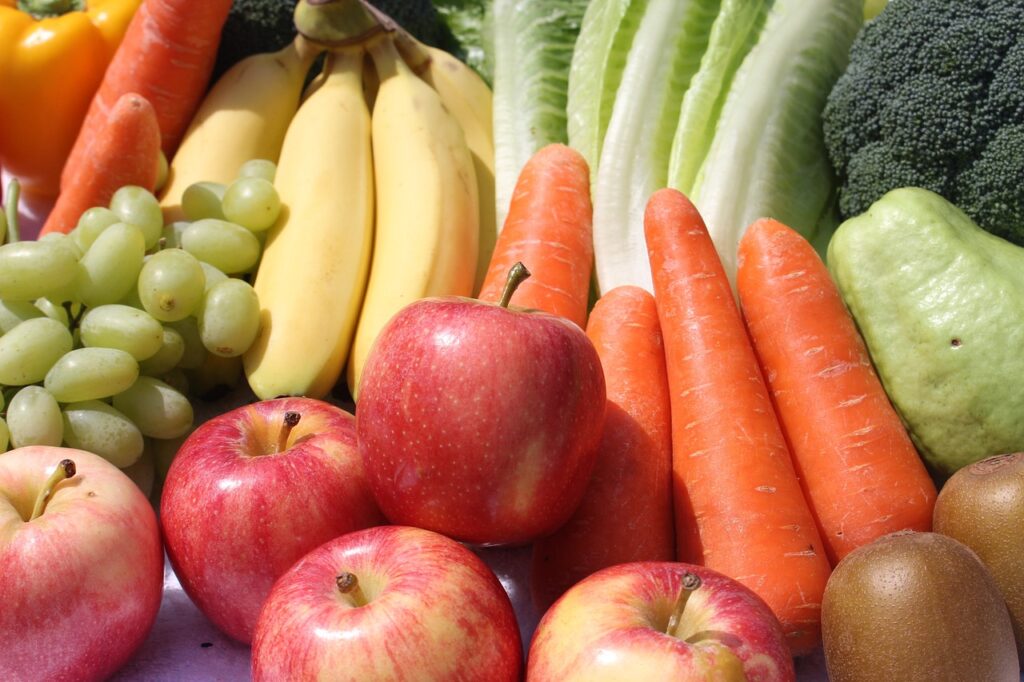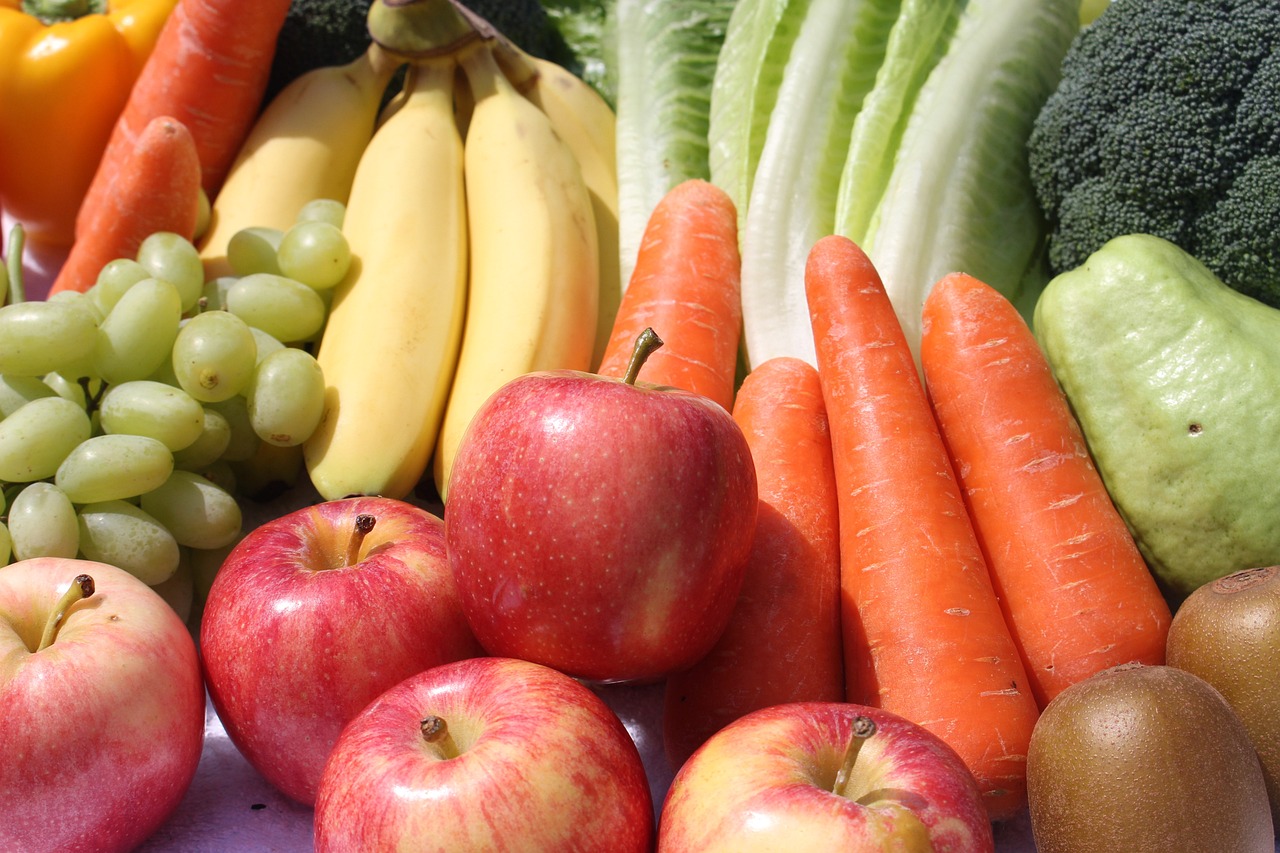Why should we eat the rainbow vegetables and fruits?
What each color says?

Eating a variety of colorful just like rainbow vegetables and fruits in often recommended because each color group contains different phytonutrients and consuming a rainbow of colors and sure a broad range of health benefits. Here are some common phytonutrient rich colors and their associated benefits. Plants contain different phytonutrients, which give them their color. Different colored plants are linked to higher level of specific nutrients and health benefits.
Eating more different types of fruits and vegetables (Rainbow vegetables) will increase your intake of different nutrients to benefit all areas of your health. Almost all studies show that by getting a variety of colors from fruits and vegetables in your diet, you are giving your body an array of vitamins, minerals and phytochemicals to benefit your overall health.
All colorful fruits and vegetables (rainbow vegetables) have anti-inflammatory and antioxidant effects that may benefit different aspects of your health. Each color represents a different phytonutrient and set of nutrients that may benefit your health. We make some mistakes while eating. To get more insights about eating mistakes and how to correct by modifications, read this article, https://sparklinglifestyle.in/eating-mistake-correct-by-modification/
Red colored vegetables and fruits for inflammation:
They contain Anthocyanins and lycopene. They also contain vitamin C, vitamin A, and potassium. They help in inflammation, cancer, heart disease and brain function. For example, Tomatoes, Beets, Red peppers, Pomegranate, Strawberries and Watermelon. Red colored vegetables and fruits are also called “carotenoids”, which are known as antioxidants.
These carotenoids reduce free radicals, which are formed naturally in our body as a byproduct of all over usual bodily processes, such as breathing and moving, but they also come from UV light exposure, smoking, air pollutant and industrial chemicals. These free radicals create oxidative stress, which contributes to ageing, inflammation, heart disease, and cancer. Increasing antioxidants like red colored vegetables and fruits (rainbow vegetables) in your diet lowers oxidative stress and reduces the risk of many diseases, like arthritis, type 2 diabetes, heart disease, stroke and cancer.
Orange colored fruits and vegetables for reproductive health:
They contain carotenoids and bioflavonoids. These orange color compounds are found in ovary. They are useful in hormonal health, reproduction, skin, hair, eye health and endometriosis. For example, Orange, Papaya, Mango, Apricots and carrots. Orange colored fruits and vegetables contain alpha, and beta carotene are converted to vitamin A in our bodies, which is important for healthy eyes and good eyesight.
Yellow colored vegetables and fruits for happiness and digestion:
They are fire element. They are high in tryptophan, that produce serotonin (happiness hormone). They help in indigestion or nausea and help liver to detoxify. For example, Pineapple, Lemon, Banana and Ginger. Yellow colored fruits and vegetables (rainbow vegetables) also contain lutein, meso-zeaxanthin and zeaxanthin have been shown to particularly important for eye health, and can reduce the risk of age-related macular degeneration, which leads to blurring of your central vision. These phytonutrients can also absorb UV light in your eyes, acting like sunscreen for the eyes and protecting them from sun damage.
Green colored vegetables and fruits for heart and blood or detoxification:
They contain chlorophyll. They are helpful in heart health and blood build. They have antioxidant property. For example, All leafy greens, Wheatgrass, Broccoli, Kale, Sea vegetables, Avocado, Green grapes and Kiwi. Green colored fruits and vegetables (rainbow vegetables) also contain catechins, epigallocatechin gallate, phytosterol, nitrates and also important nutrient known as folate, vitamin B9.
These nutrients also provide important benefits in keeping your blood vessels healthy by promoting something called “vasodilatation”. This improves blood circulation and reduces blood pressure, reducing our risk of heart and other vessel complications and disease. Folate is recommended before pregnancy because it helps reduce the risk of congenital anomalies in babies. Folate helps the development of the fetal nervous system during the first trimester of pregnancy.
Blue, purple-colored vegetables and fruits for brain health:
They contain Flavonoids and Proanthocyanins. They are useful in brain health, mood, learning and memory. For example, Eggplant, Blackberries, Blueberries, Plums and Raisins. Blue- and purple-colored fruits and vegetables also contain resveratrol and tannins. Anthocyanins also have antioxidant properties, and so provide benefits in reducing the risk of cancer, heart disease and stroke.
White and brown colored fruits and vegetables:
They’re not as vibrant in color, still certain beneficial phytonutrients. For example, Onions, Garlic, Mushroom and Cauliflower. Allicin in garlic has anti-microbial properties. Glucosinolates in cruciferous vegetables are associated with Cancer prevention.
Conclusion:
In summary, incorporating a variety of colorful vegetables and fruits (rainbow vegetables) into your diet and shows a wide array of phytonutrients, each with unique health benefits. Remember, that cooking methods can affect the nutrient content, so it’s generally best to steam or lightly sautéing vegetables to preserve their phytonutrients.



Leave a Comment